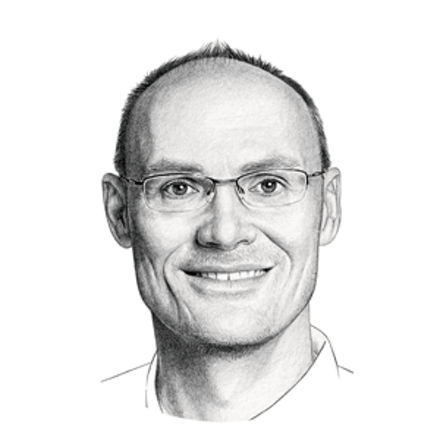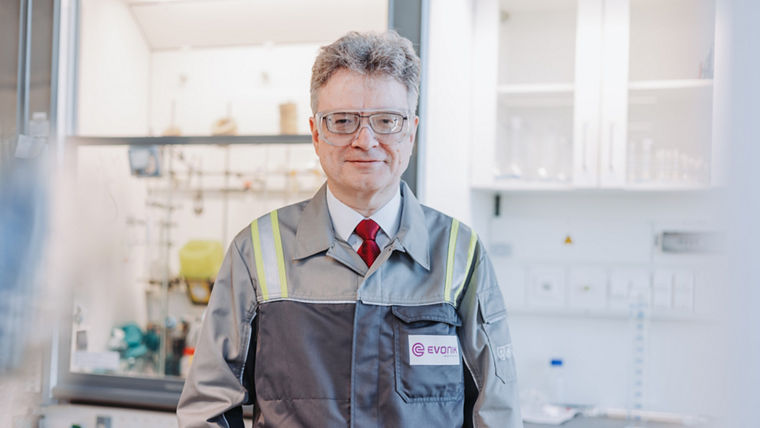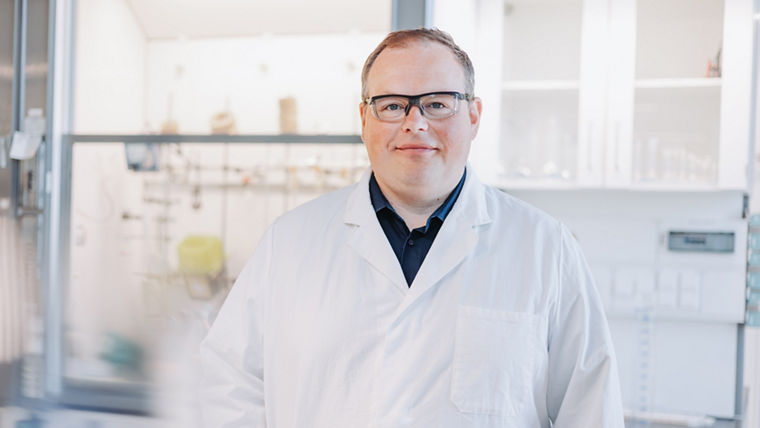The new methanol plant from project developer European Energy is one of the largest of its kind anywhere in the world. Located in the Danish town of Apenrade, it is set to supply 42,000 tons of this alcohol per year in the future, including as fuel for the container ship Laura Maersk. The special feature of the plant with the gray-green halls and the many pipelines is that it manufactures methanol in an environmentally friendly way—from carbon dioxide and from hydrogen, which is produced directly on site in an electrolysis plant.
In this electrolyzer, water is split into its components oxygen and hydrogen using electricity from solar and wind energy.

The hydrogen is then processed directly on site. Specialists refer to such technologies as Power-to-X systems. This means using electricity from renewable energy to produce valuable raw materials such as methanol that were previously obtained from natural gas, coal or mineral oil. The energy sector and industry have high hopes for Power-to-X. Analysts expect the Power-to-X market to grow strongly in the coming years. Last year, it was valued at around 700 million US dollars worldwide. It is expected to rise to more than 1.6 billion US dollars by 2032. However, much remains to be done. It is still unclear whether and how quickly it will be possible for Power-to-X to make industry sustainable, not least the chemical industry.
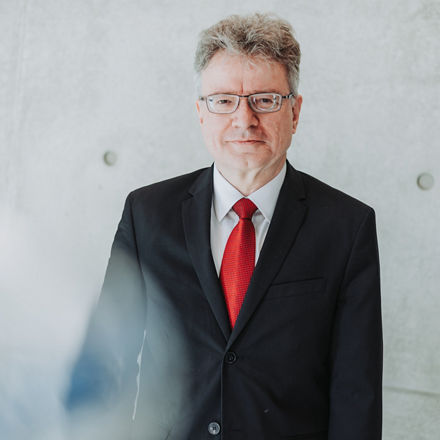
»The chemical industry is facing a paradigm shift«
Prof. Robert Franke Power2ValueChemicals project Coordinator
After all, in the future, Power-to-X will supply not only hydrogen and methanol but also other chemicals, of which the industry requires large quantities and which have so far been obtained to a large extent from petroleum and natural gas. “The chemical industry is facing a paradigm shift. In the long run, we’ll have to say goodbye to fossil raw materials,” says Professor Robert Franke, a chemist at Evonik subsidiary Oxeno. In the large-scale Power2ValueChemicals project, experts from Oxeno have therefore teamed up with industry and research partners to explore how Power-to-X can make traditional chemical processes greener. They want to use carbon dioxide as a raw material to produce carbon monoxide (CO), which industry has so far obtained from natural gas.

CO is needed for the production of perfumes, lubricants, active pharmaceutical ingredients, and polyamide, among other things. The Power2ValueChemicals approach would make the chemical industry greener in two ways. For one thing, the greenhouse gas carbon dioxide would be used as a raw material and be bound in products. Moreover, the fossil raw material natural gas would no longer be needed.
But is the effort worth it?
Power2ValueChemicals is an unusual project, because the entire chain from making CO from carbon dioxide to the finished chemical product has rarely been tried out on an industrial scale. One of the two case studies will deliver methyl valerate as an end product. This is a compound that is found in ripe pineapple fruit, among other things, and serves as an important fragrance in the perfume industry. “We not only have to solve technical issues, but also analyze how high the energy consumption and costs of the entire value chain are,” says Franke, who coordinates the Power2ValueChemicals project. “A valid and critical practical assessment is needed to decide whether such a facility could be set up on an industrial scale.” In this respect, it will be exciting to see what happens when the experiments gradually start and the test facilities go into operation.

The process can be roughly divided into two main areas. It starts with electrolysis, in which carbon dioxide (CO2) is split into its components: one CO molecule and one oxygen atom (O). The CO is then used to produce methyl valerate. Two electrolysis pilot plants from Siemens Energy are used for electrolysis in Power2ValueChemicals. They were developed and tested by the project partner in Erlangen and Munich and reliably deliver carbon monoxide. However, the yield of CO is still too low, so the process needs to be optimized. “We are now tackling this task together with Siemens Energy,” says Dr. Alexander Bauer, an electrochemist at Forschungszentrum Jülich, another project partner. “We systematically and simultaneously change the parameters pressure and temperature as well as other settings to obtain more CO.”
The researchers are delving deep into the chemical and technical details of the electrolysis. At its heart is a silver catalyst embedded in a plastic membrane. The CO2 splits into CO and an oxygen atom at this catalyst.
“We developed the catalyst membrane and the entire system for carbon monoxide production ourselves over a number of years,” explains Dr. Elfriede Simon from Siemens Energy. The company currently has two electrolysis facilities

First, the smaller system will now go into operation in Jülich. Its catalyst-membrane reaction surface measures around 300 square centimeters. Later, the large facility with its 5,000 square centimeter membrane will be brought to Jülich. “It’s much easier for us to carry out experiments on small systems first,” says Bauer. “You need less gases and liquids, and the whole handling process is easier.”
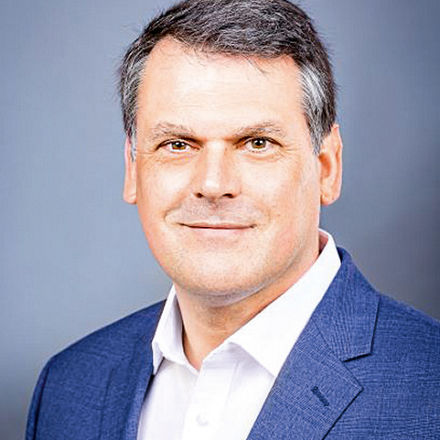
»We tease out the optimum conditions«
Alexander Bauer electrochemist at Forschungszentrum Jülich, Germany
The yield of the electrolysis is usually optimized by successively changing individual parameters such as the pressure. “In contrast, we change several parameters at the same time in order to tease out the optimum conditions,” explains Bauer. For each setting, he conducts several experiments to determine whether the process improves significantly. “Ultimately, this is a statistical optimization process,” he says. This approach is also known as “experimental design”.
THEORY MEETS REALITY
However, even an optimally adjusted electrolysis system always produces byproducts, such as hydrogen or oxygen compounds. In addition, carbon dioxide that has not been split into CO and oxygen is left over. “Electrolysis always produces a mixture of gases. That’s why we talk about product gas instead of pure carbon monoxide,” says Bauer. One challenge for the Power2ValueChemicals partners is that such gas mixtures are unusual in the chemical industry. At present, carbon monoxide is obtained from natural gas via steam gas reforming. This supplies very pure CO. “In Power2ValueChemicals, we also have to find out whether our established production processes can deal with the other components in the product gas,” says Evonik expert Franke.

The production of methyl valerate will now show whether this works. The central chemical reaction for its production is methoxycarbonylation, during which the CO molecule is incorporated into a butene molecule—a small chain molecule consisting of four carbon atoms and eight hydrogen atoms (see diagram below). The project partners are testing how well methoxycarbonylation works with the gas mixture from the electrolysis in two ways—firstly in the laboratory with extremely sensitive measuring equipment and secondly in a large test facility.
Power2VC
This is how carbon dioxide is converted into valuable chemicals.

The laboratory experiments are taking place at another project partner, the Max Planck Institute for Chemical Energy Conversion (MPI CEC) in Mülheim an der Ruhr. The test facility, in turn, will go into operation at the Evonik site in Marl. In a long-term test lasting 4,000 hours, which corresponds to just under half a year, the experts there check whether the methoxycarbonylation using the gas mixture is stable in operation. If this is not guaranteed, the consequences are far-reaching. The system would have to be cleaned and possibly even dismantled, causing production downtimes of many hours or even several days.
The research team at the MPI CEC in Mülheim is therefore looking in detail at how the chemical reactions take place. Chemical engineer Lisa Steinwachs has developed and constructed a head-height laboratory system made of stainless steel containers and tubes, which is shielded by transparent acrylic glass walls in one of the Mülheim laboratories.
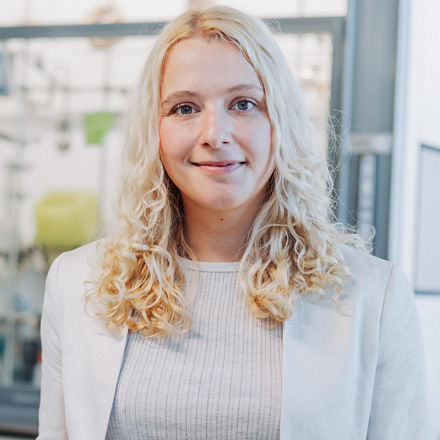
»he process is currently running at 30 bar. We may need higher pressures«
Lisa Steinwachs Chemical engineer at the MPI
The actual methoxycarbonylation reaction takes place in a stainless steel container the size of a coffee pot. It is about half filled with methanol. The product gas containing CO is fed in from above. In addition, a catalyst is pumped into the reactor in precisely metered doses. It drives the decisive reaction—the incorporation of CO into the short hydrocarbon chain molecule. Instead of butene, which is needed to make methyl valerate, Steinwachs is currently using a different hydrocarbon: hexene. Hexene is liquid and therefore easier to mix with liquid methanol. Butene, on the other hand, exists as a gas. “This makes it easier to control the reaction,” says Steinwachs. “Once we have gained some initial experience, we will switch to gaseous butene and produce methyl valerate.”
The decisive factor for methoxycarbonylation is how the catalyst behaves. Can it deal with the gas mixture? Or does it react with the CO2 in the reaction gas to form solid complexes, causing it to fail at some point? Or does it even break down all by itself in an autocatalytic decomposition?
“We clarify such questions on our small system before the long-term trial in Marl starts,” says Steinwachs, “because it’s easier to dismantle and clean if the reaction suddenly breaks down.”
ELEMENTS-Newsletter
Receive exciting insights into Evonik's research and its social relevance—conveniently via email.
It gets exciting from 70 bar
In Mülheim, chemical reactions can be observed live in an operando analysis. To accomplish this, the laboratory is equipped with appropriate analytical equipment that allows scientists to track which molecules are produced in the reactor and react with each other—and whether the catalyst is inhibited by carbon dioxide or its reaction products. The lab’s inventory includes nuclear magnetic resonance spectrometers, which identify molecules using magnetic fields, and devices that detect substances using infrared light. “The operando method is something special,” says Dr. Andreas Vorholt, a chemist and research group leader at the MPI CEC. “It greatly helps us in taking a step-by-step approach to improving methoxycarbonylation with the electrolysis-generated product gas.”
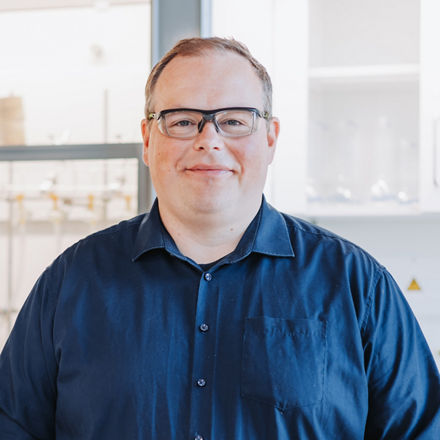
»We are finding out what problems and risks there are«
Andreas Vorholt Chemist and working group leader at MPI CEC
Another challenge is that the carbon dioxide in the product gas dilutes the CO. For the reaction with the catalyst, this means that the catalyst and CO come together less frequently and the process only produces a small amount of methyl valerate in the end. Ultimately, the pressure in the reaction tank must be increased so that the CO and the catalyst get closer together. “The process is currently running at 30 bar. We may need higher pressures,” says Lisa Steinwachs. If around 70 bar is required, it would get exciting. The carbon dioxide could then enter the supercritical state, a kind of hybrid state between solid and liquid, in which it is particularly reactive. This would make the process much more demanding because the plant would have to be designed more robustly—for example with thicker steel containers and more robust seals and hoses. “We are also responsible for de-risking in the project. We are finding out what problems and risks there are before the large test facility in Marl, which is expensive to run, goes into operation,” says Andreas Vorholt.
All in all, Power2ValueChemicals is an extraordinary project, emphasizes Robert Franke. It is supported by the Kopernikus initiative of the Federal Ministry of Education and Research, which funds large-scale energy projects. “Our project is one of the most chemistry-oriented under the Kopernikus umbrella,” says Franke. “We have created a practice-oriented large-scale chemical production network and thoroughly examined complex catalyst systems with which we can run through the entire value chain.” As an industrial partner, Evonik has the necessary expertise to assess whether green methoxycarbonylation will ultimately pay off.
Evonik and Siemens Energy are therefore also carrying out a life cycle analysis in the project, from electrolysis to the finished ester. “The outcome is still open,” says Franke. However, Power2ValueChemicals is making a significant contribution to finding out how the chemical industry can move away from fossil raw materials.


